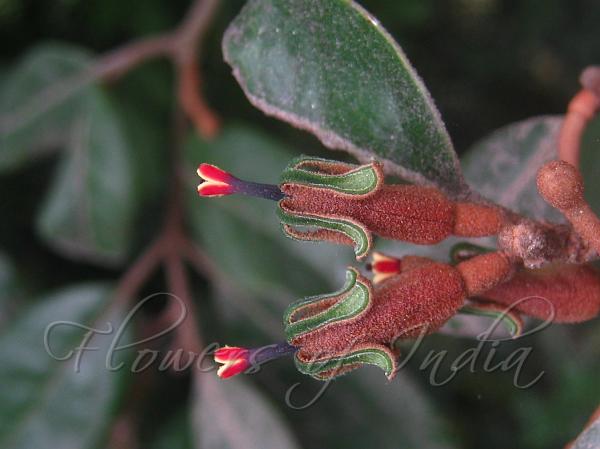|
| Rusty Mistletoe |
|

|

| File size | 487465 |
| Original date | 9/15/12 9:42 AM |
| Resolution | 2048 x 1536 |
| Flash | Flash did not fire, auto |
| Focal length | 6.6mm |
| Exposure time | 1/80s |
| Aperture | 3.0 |
| Focus Distance | |
| Metering Mode | Center weighted average |
| Camera make | Canon |
| Camera model | Canon PowerShot A495 |
| Sensor type | OneChipColorArea |
|
|
|
|
Photo: |
Botanical name: Taxillus vestitus Family: Loranthaceae (Mistletoe family)
Synonyms: Loranthus vestitus
Synonyms: Loranthus vestitus
Rusty Mistletoe is a parasitic shrub with young
shoots velvet-hairy. Leaves are opposite, elliptic-ovate to
lanceshaped, 4-7 cm long, entire, pointed to blunt, rusty velvety on
the lower surface, base narrowed in to the 0.6-1 cm long, velvety
stalk. Flowers are stalkless, in fascicles in leaf axils, 1.7-2 cm
long, rusty velvety, bract subulate, 1.5 mm long, velvety. Calyculus is
3 mm long, pubescent. Flower-tube is about 7 mm long, rusty velvety,
split along one side, lobes 4, 1 cm long, spoon-shaped. Stamens are 4,
epiphyllous, filaments 7 mm long, hairless, crimson, anthers 2 mm long.
Ovary is oblong to obovoid, 3 mm long, velvety, fused with the
calyculus, style crimson, 1.7 cm long; stigma capitate. Fruit is
ellipsoid, about 7 mm long, rusty, becoming hairless. Seed is 1, about
4 mm long, embedded in a viscid pulp. Rusty Mistletoe is found in the
Himalayas, from Garhwal to Nepal and Assam, at altitudes of 50-1500 m.
Flowering: September-January.
| Identification credit: Krishan Lal | Photographed in Sirmaur Distt, Himachal Pradesh. |
• Is this flower misidentified? If yes,